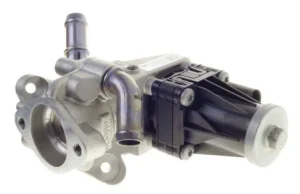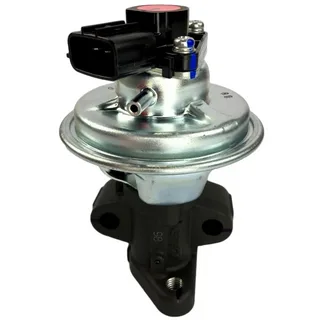The Ford-Ranger EGR Valve is crucial in maintaining your vehicle’s performance and reducing emissions. However, like any component in your car, regular attention and care are required to ensure it functions correctly. This guide will walk you through how to properly maintain your Ford Ranger EGR Valve, helping you avoid potential issues and prolonging the life of your vehicle. By adhering to these steps, you’ll ensure optimal performance and efficiency while reducing the risk of costly repairs down the road. Regular maintenance is vital to keeping your Ford Ranger running smoothly and reliably.
Understanding the EGR Valve Function
The EGR valve recirculates a portion of exhaust gases back into the engine cylinders, reducing nitrogen oxide emissions and enhancing fuel efficiency. Lowering the combustion temperature mitigates engine knocking and improves overall engine performance. The valve ensures a balanced mix of fresh air and exhaust gases, which is crucial for optimal engine operation. Understanding this process helps recognise the importance of maintaining the EGR valve for environmental benefits and vehicle efficiency.
Signs of a Faulty EGR Valve
When maintaining your Ford Ranger, paying attention to the symptoms of a faulty EGR (Exhaust Gas Recirculation) valve is crucial. This component is vital in reducing emissions and ensuring optimal engine performance. Here are some key symptoms to watch for:
- Rough Idling: If your Ford Ranger starts to idle roughly or inconsistently, it could indicate that the EGR valve is malfunctioning. This can lead to a decrease in engine performance overall.
- Diminished Fuel Efficiency: A failing EGR valve can disrupt the air-fuel mixture, causing the engine to work harder and use more fuel. If you notice a drop in fuel efficiency, it’s worth investigating the EGR system.
- Increased Exhaust Emissions: A malfunctioning EGR valve can lead to higher emissions, which may cause your vehicle to fail emissions tests. This has environmental implications and can also lead to legal issues.
- Check Engine Light: The check engine light illuminates your dashboard, a clear sign that something is wrong. It could point to the EGR valve or other related components.
- Engine Knocking and Sluggish Acceleration: These could be further indicators of EGR issues if you hear knocking noises or experience sluggish acceleration. Ignoring these symptoms can lead to more significant engine damage over time.
By detecting these issues early, you can avoid more costly repairs down the line. Regular maintenance and attention to these warning signs will keep your Ford Ranger running smoothly.
Importance of Regular Maintenance
Neglecting the maintenance of your Ford-Ranger EGR Valve can lead to increased emissions and reduced engine efficiency. Routine checks and cleanings are essential to prevent the buildup of carbon deposits, a common issue leading to EGR valve failure. This proactive approach helps avoid damage to other engine components, ensuring smoother vehicle operation. Regular maintenance is vital to keeping your Ford Ranger running efficiently and sustainably.
Tools and Materials Needed
The right tools are essential to perform adequate maintenance on your EGR (Exhaust Gas Recirculation) valve. This ensures a smoother process and helps you address any issues efficiently.
Essential Tools for EGR Valve Maintenance
Maintaining your vehicle’s Exhaust Gas Recirculation (EGR) valve is crucial for optimal engine performance and reduced emissions. Regular maintenance helps ensure the EGR system functions correctly, improving fuel efficiency and prolonging the engine’s lifespan. Here are essential tools to keep in your toolkit for effective EGR valve maintenance.
- Spanner Set: A comprehensive spanner set will help you securely loosen and tighten various bolts and nuts, allowing for easy removal and installation of the EGR valve.
- Screwdrivers: Both flathead and Phillips screwdrivers are necessary for removing screws that may secure components around the EGR valve, ensuring you can access it without hassle.
- Clean Cloth: Keep a clean cloth handy to wipe down surfaces and prevent dirt from entering the engine during maintenance. This helps maintain a clean working environment.
- Vacuum Tester: Using a vacuum tester can help assess the functionality of the EGR valve. This tool ensures that the valve opens and closes properly, which is crucial for optimal engine performance.
- Wire Brush: A wire brush is useful for cleaning any carbon buildup on the EGR valve and surrounding areas. Removing this buildup can improve the valve’s efficiency and prolong its lifespan.
- EGR Valve Cleaner: An EGR valve cleaner is specifically designed to break down carbon deposits, making it easier to clean the valve effectively.
- New Gasket: It’s advisable to have a new gasket ready. If the old one becomes damaged during removal, a new gasket will ensure a proper seal when reinstalling the EGR valve.
With these tools prepared, you’ll be well-equipped to maintain your EGR valve, enhancing your vehicle’s performance and longevity.
Safety Precautions
Safety should be your top priority when performing maintenance on your vehicle, mainly when dealing with components like the EGR (Exhaust Gas Recirculation) valve. Following these guidelines will help ensure a safe and effective cleaning process.
Ensure the Engine is Cool
Before starting, confirm that the engine is completely cool. This prevents burns and makes handling parts safer.
Wear Protective Gear
Always wear protective gloves and eyewear. This helps safeguard against chemical exposure and flying debris, protecting your skin and eyes.
Prepare Your Workspace
Park your vehicle on a flat surface and engage the handbrake. This ensures stability while you work. Disconnect the battery to prevent any electrical issues during the process.
OrganOrganise Tools
Keep all tools organised and within reach. A tidy workspace reduces the risk of slips and injuries while you focus on the task at hand.
Ventilate the Area
Work in a well-ventilated area. Fumes from EGR valve cleaners can be harmful, so good airflow is essential to avoid inhaling toxic substances.
Adhering to these safety measures can effectively clean your vehicle’s EGR valve while minimally associated with automotive maintenance. Remember that a cautious approach can prevent accidents and ensure a smoother process.
Locating the P4-At EGR
The P4-At EGR valve in your Ford Ranger is generally found near the intake manifold. Refer to your vehicle’s manual for precise identification, as the location can vary by model year. Carefully follow the visual guides and diagrams provided in the manual to ensure you pinpoint the exact spot. Familiarising yourself with the engine compartment layout beforehand will make the process easier and more efficient.
Removing the EGR Valve
Disconnect any electrical connectors or vacuum hoses attached to the EGR valve. This step is crucial to prevent connector damage and ensure a smooth removal process. After disconnecting, use the correct spanner to unbolt the valve carefully from its position, supporting the valve as you loosen the bolts. It’s essential to ensure that you do not damage any surrounding components during this process, as they can be delicate and easily affected. Once the bolts are loose, please remove them and keep them safe for reinstallation; organising can save time later. Work methodically, focusing on each step to avoid mishaps that could lead to complications.
A clean working area is essential—before proceeding with the removal, ensure the space is free of dirt and debris. This helps maintain the integrity of the components and allows for easier inspection of the EGR valve and surrounding areas for any signs of wear or damage. Preparing appropriately will contribute to a successful removal and reinstallation process, ensuring that your vehicle functions optimally after the work is completed. Proper preparation and attention to detail are key to avoiding unnecessary issues and maintaining the performance of your engine.
 Cleaning the EGR Valve
Cleaning the EGR Valve
Carefully remove carbon deposits and debris from the valve using an EGR valve cleaner and a wire brush. Make sure to clean all passages and ports to allow optimal airflow. Let the cleaner soak for a few minutes before scrubbing for more effective results. After washing, wipe the valve with a clean cloth and let it dry completely. Ensuring no residue is left inside the valve is crucial, as this can impact its performance. Pay close attention to all the nooks and crannies to ensure thorough cleaning. This detailed cleaning will help maintain the efficiency and longevity of your Ford-Ranger EGR Valve.
Inspecting the EGR Valve
Carefully examine the cleaned EGR valve for any signs of damage, such as cracks, holes, or deformities. Check the valve mechanism to ensure it moves freely without obstruction. Inspect the electrical connectors and vacuum hoses for wear or damage that could affect performance. If any component appears compromised, consider replacing the valve to maintain optimal function. Regular inspection helps identify potential issues before they escalate, saving on costly repairs and ensuring your Ford Ranger runs efficiently.
Reinstalling the EGR Valve
If necessary, place a new gasket, then carefully bolt the EGR valve back into its position using the bolts set aside earlier. Reattach all electrical connectors and vacuum hoses to their respective places, ensuring each connection is secure to prevent leaks. Take care not to overtighten bolts, which could damage the valve or its mount. Double-check that all components are correctly aligned and firmly connected. Once everything is in place, reconnect the battery and ensure the engine bay is clear of any tools or debris.
Testing the EGR Valve
Start the engine and let it idle, paying close attention to any unusual noises or rough idling. Use a vacuum tester to verify that the EGR valve is opening and closing correctly, ensuring no leaks. If any irregularities are detected, further inspection may be required. Monitoring the engine’s performance during this stage helps identify any residual issues that might have been overlooked. If problems persist, consider seeking professional assistance to prevent any long-term damage.
Routine Maintenance Tips
Routine maintenance of your Ford-Ranger EGR Valve is vital for optimal performance. Regularly inspect and clean the valve to prevent carbon build-up, especially if you often drive in urban areas with frequent stop-and-go traffic. Monitor fuel efficiency and engine performance, as significant changes could indicate EGR valve issues. Additionally, make it a habit to check the valve’s electrical connectors and vacuum hoses for any signs of wear or damage. Consulting your vehicle’s manual for specific maintenance schedules will help you stay on track. These tips will help you maintain a well-functioning EGR valve, enhancing your Ford Ranger’s overall performance and longevity.
Conclusion
Proper maintenance of your Ford Ranger EGR Valve ensures optimal performance and reduces emissions. By following these steps, you can effectively clean and inspect the valve, preventing common issues associated with neglect. Regular checks enhance fuel efficiency and prolong the lifespan of your vehicle’s engine. A well-maintained EGR valve contributes significantly to your Ford Ranger’s overall reliability and environmental friendliness. Make it a habit to incorporate EGR maintenance into your routine vehicle care to enjoy a smoother driving experience and avoid costly repairs.
FAQs
How often should I clean my Ford Ranger EGR Valve?
It’s advisable to clean the Ford Ranger EGR Valve every 30,000 to 50,000 miles or as part of regular maintenance, especially if you notice a malfunction.
What are the symptoms of a failing EGR valve?
Common symptoms include rough idling, decreased fuel efficiency, increased exhaust emissions, the check engine light activation, and engine knocking or sluggish acceleration.
Can I drive my Ford Ranger with a faulty EGR valve?
While it may still run, driving with a faulty EGR valve can lead to reduced performance, increased emissions, and potential engine damage, so it’s best to address any issues promptly.
Is replacing the gasket when reinstalling the EGR valve necessary?
Yes, replacing the gasket is crucial to ensure a proper seal and prevent any exhaust leaks, which can affect engine performance.
Can I perform EGR valve maintenance myself?
Yes, you can perform EGR valve maintenance at home with the right tools and knowledge. However, if you’re uncertain, consulting a professional mechanic is recommended.

